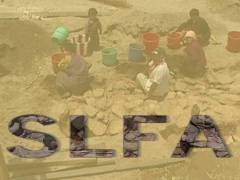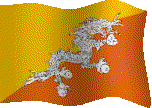Reference:
Author: Palden Tshering
Editor:
Kuensel (newspaper): Thimpu, Kingdom of Butan
Date:
June 17th, 2000
Text:
follows
Swiss
Team Dates Archaeological Finds
Radiocarbon
tests, conducted by a Swiss archeologist and an anthropologist, have dated
the archeological finds at Jakar, Bumthang, to two periods: end of the
eighth to the beginning of the ninth century and the mid-16th century.
Archeologist
Reto Blumer and his anthropologist wife Frederique Vial returned to Bhutan
earlier this year, with a geologist and a biologist from the Swiss-Liechtenstein
Foundation for Archeological Research Abroad, to continue their research.
Last year
they identified the four structures first found while excavations were
being carried out for the construction of a new RNR-Research Centre in
Jakar two years ago and have made more discoveries recently.
The first,
an underground stone masonry structure about 5.3 metres in height, has
been confirmed to have been built between the eighth and ninth centuries
while the second, a partly exposed stone wall 1.2 metres in width and 26.5
metres in length, is believed to have been used as a fort wall.
The third
is a platform-like structure surrounded by a peripheral stone wall, encompassing
a trapezoid surface, believed to have been used for rituals. But the archeologist
is yet to relate the trapezoid shape to others in Bhutan.
Many pottery
remains were unearthed inside the 2.8 by 2.5 metre chamber of the platform
structure. At the bottom a possible painting on the mud floor was discovered
but, Mr. Reto Blumer said, it had been preserved very badly.
The fourth
structure is believed to be a tower foundation.
Last year
Mr. Reto Blumer and his wife found remains of camp fires inside the first
and second structures, proving that it was used by persons who probably
had camps in and around the fortifications. They also discovered that after
the use of the fortifications the structures were filled up with stones
to make it difficult for any one else to use at a later stage.
The Swiss
team has also managed to collect small broken pieces of pottery and a grinding
stone that helped date the period of the structures.
Mr. Reto
Blumer said it was hard to say exactly who had built the structures but,
having dated to the 16th century, it was probably built by the local population
who inhabited the area at the time.
The on-going
excavation involves the SDC/Helvetas, the National Commission for Cultural
Affairs, and the Swiss Liechtenstein Foundation.
More discoveries
are expected.
By Palden Tshering
..back to top
of article
|
|
Article
in Kuensel, the Bhutanese National Newspaper
To
enjoy bhutanese news, click the link below
 |




 .
.